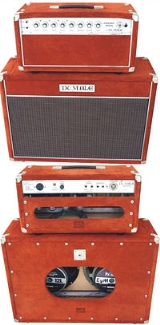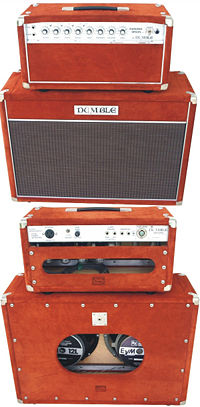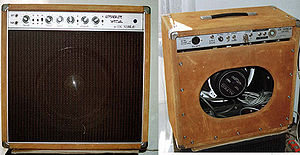
Dumble Amplifiers
Encyclopedia

Los Ángeles
Los Ángeles is the capital of the province of Biobío, in the commune of the same name, in Region VIII , in the center-south of Chile. It is located between the Laja and Biobío rivers. The population is 123,445 inhabitants...
, California
California
California is a state located on the West Coast of the United States. It is by far the most populous U.S. state, and the third-largest by land area...
. Dumble began making amplifiers
Guitar amplifier
A guitar amplifier is an electronic amplifier designed to make the signal of an electric or acoustic guitar louder so that it will produce sound through a loudspeaker...
in the late 1960s in Santa Cruz
Santa Cruz, California
Santa Cruz is the county seat and largest city of Santa Cruz County, California in the US. As of the 2010 U.S. Census, Santa Cruz had a total population of 59,946...
. There are reportedly fewer than 300 in total. Amplifier models have included the Overdrive Special (ODS), Overdrive Reverb, Steel String Singer (SSS), Dumbleland, Phoenix (a rack mounted amp), Hotel Hog and Winterland. Dumble amplifiers are considered to be one of the few precursors to the explosion of Boutique amplifier companies on the market.
Musicians who have used Dumble amplifiers include: Carlos Santana
Carlos Santana
Carlos Augusto Alves Santana is a Mexican rock guitarist. Santana became famous in the late 1960s and early 1970s with his band, Santana, which pioneered rock, salsa and jazz fusion...
, John Mayer
John Mayer
John Clayton Mayer is an American pop rock and blues rock musician, singer-songwriter, recording artist, and music producer. Born in Bridgeport, Connecticut and raised in Fairfield, Connecticut, he attended Berklee College of Music in Boston. He moved to Atlanta in 1997, where he refined his...
, Al Di Meola
Al Di Meola
Al Di Meola is an acclaimed American jazz fusion and Latin guitarist, composer, and record producer of Italian origin. With a musical career that has spanned more than three decades, he has become respected as one of the most influential guitarists in jazz to date...
, Robben Ford
Robben Ford
Robben Ford is an American blues, jazz and rock guitarist.-Biography:Ford was born in Woodlake, California, United States, but raised in Ukiah, California, and began playing the saxophone at age 10, picking up the guitar at age 13...
, Larry Carlton
Larry Carlton
Larry Carlton is an American jazz, smooth jazz, jazz fusion, pop, and rock guitarist and singer. He has divided his recording time between solo recordings and session appearances with various well-known bands...
, Eric Johnson
Eric Johnson
Eric Johnson is an American guitarist. Though he is best known for his success in the instrumental rock format, Johnson regularly incorporates jazz, fusion, gospel and country and western music into his recordings...
, Stevie Ray Vaughan
Stevie Ray Vaughan
Stephen Ray "Stevie Ray" Vaughan was an American electric blues guitarist and singer. He was the younger brother of Jimmie Vaughan and frontman for Double Trouble, a band that included bassist Tommy Shannon and drummer Chris Layton. Born in Dallas, Vaughan moved to Austin at the age of 17 and...
, Ben Harper
Ben Harper
Benjamin Chase "Ben" Harper is an American singer-songwriter and musician. Harper plays an eclectic mix of blues, folk, soul, reggae and rock music and is known for his guitar-playing skills, vocals, live performances and activism. Harper's fan base spans several continents...
, Lowell George
Lowell George
Lowell Thomas George was an American singer-songwriter, multi-instrumentalist, and producer, who was the main guitarist and songwriter for the rock band Little Feat.- Early years :...
, Steve Lukather
Steve Lukather
Steve "Luke" Lukather is an American guitarist, singer, songwriter, arranger, and record producer best known for his work with the rock band Toto. Lukather has played with many artists, released several solo albums, and worked as a composer, arranger, and session guitarist on more than 1,500 albums...
, Sonny Landreth
Sonny Landreth
Sonny Landreth is an American blues musician from southwest Louisiana who is especially known as a slide guitar player. He was born in Canton, Mississippi, but soon after, his family moved to Jackson, Mississippi, before settling in Lafayette, Louisiana...
, Stephen Bruton
Stephen Bruton
-Background:Born in Wilmington, Delaware as Turner Stephen Bruton, he moved with his family to Texas at the age of two. He fell into the Fort Worth music scene after graduating from Texas Christian University when he joined Kris Kristofferson's band as the latter's career was about to take off;...
, Jackson Browne
Jackson Browne
Jackson Browne is an American singer-songwriter and musician who has sold over 17 million albums in the United States alone....
, David Lindley
David Lindley (musician)
David Perry Lindley is an American musician who is notable for his work with Jackson Browne, Warren Zevon, and other rock musicians. He has worked extensively in other genres as well, performing with artists as varied as Curtis Mayfield and Dolly Parton...
and Dean Parks
Dean Parks
Dean Parks is an American session guitarist and record producer from Ft. Worth, TX.-Albums:Dean was member of The North Texas State One O'clock Lab Band before moving to Los Angeles to work with Sonny and Cher in 1970. Dean is best-known through his many contributions to albums by Steely Dan...
.
Influence
A number of companies have produced amplifiers somewhat based on the Dumble Overdrive Special. Some DIYDo it yourself
Do it yourself is a term used to describe building, modifying, or repairing of something without the aid of experts or professionals...
amplifier-building hobbyists have also started to build Dumble-influenced amplifiers from unofficial schematics and inside-chassis photographs circulating on the Internet, although many have been voluntarily taken down following requests from Mr. Dumble.
Dumble's German
Germany
Germany , officially the Federal Republic of Germany , is a federal parliamentary republic in Europe. The country consists of 16 states while the capital and largest city is Berlin. Germany covers an area of 357,021 km2 and has a largely temperate seasonal climate...
importer in the 1980s made a clone called the Kitty Hawk Standard. Since the 1980s, Mr. Dumble has covered the preamp circuitry of his amps with a thick layer of usually opaque epoxy
Epoxy
Epoxy, also known as polyepoxide, is a thermosetting polymer formed from reaction of an epoxide "resin" with polyamine "hardener". Epoxy has a wide range of applications, including fiber-reinforced plastic materials and general purpose adhesives....
, protecting his schematic's exact design. Several amplifiers are known to have been "de-gooped" and their component values measured. Some of the companies that produce Dumble type designs have evolved the design, adding features and creating their own sound that in some cases are a departure from the "classic" Dumble tone, functionality, layout and styling. Some companies prefer to faithfully reproduce the Dumble tones and aesthetics
Aesthetics
Aesthetics is a branch of philosophy dealing with the nature of beauty, art, and taste, and with the creation and appreciation of beauty. It is more scientifically defined as the study of sensory or sensori-emotional values, sometimes called judgments of sentiment and taste...
as closely as possible, making them available to a much wider range of players than could otherwise afford originals.
Amp makers who openly promote their "Dumble Clones" include:
- Bludotone Amp Works - BludoDrive model based on the OverDrive Special, and the Hi Plains Drifter based on the Steel String Singer
- Bruno Amps - Super 100 model based on the OverDrive Special (models for both 6L6 and EL34 power tubes)
- Carol-Ann - OD-2 model based roughly on the OverDrive Special with a more British tone
- Ceriatone - OverTone Special models based on the OverDrive Special with models for different voicings, tonestacks, and power tubes
- Fuchs Audio Technology - Overdrive Supreme models based on the OverDrive Special
- Glaswerks - Super OverDrive II model based on the OverDrive Special with voicings for amps produced in different eras
- K&M Analog Designs - A large number of amps that borrow the basic Dumble topography.
- Sebago Sound - Double Trouble line of amps based on the OverDrive Special
- Volt Amp Co uk - Over-drive Super models based around the Overdrive Special.
- Welagen Musical Sound - Overdrive Special based models, Overdrive Reverb based models, Steel String Singer based models, Angel's Breath model based on both ODS and SSS circuits.
Amps made by Mr. Dumble reportedly sell new for more than $20,000. Given the small output from Dumble, used Dumble amps often sell for more than $30,000.
Circuitry
The circuitry varies somewhat between individual amplifiers, as each one was built and voiced for a specific player. Amplifiers built around the same time tend to share some of the same circuitry and component values. However, several amplifiers were later sent back to Dumble to have their circuitry updated.Part of the characteristic sound of Dumble amplifiers is alleged to come from Dumble's choice of parts:
- the type of capacitors used in the tonestack and in the overdrive stages
- the type of plate resistors
- the output transformer
- the lead dress, and the use of shielded wire.
Dumble amplifiers are built on eyelet boards . The chassis is made of aluminum.
All Dumble amplifiers operate using vacuum tube
Vacuum tube
In electronics, a vacuum tube, electron tube , or thermionic valve , reduced to simply "tube" or "valve" in everyday parlance, is a device that relies on the flow of electric current through a vacuum...
s. Overdrive Specials use 12AX7
12AX7
12AX7 is a miniature dual triode vacuum tube with high voltage gain. It was developed around 1946 by RCA engineers in Harrison, New Jersey, under developmental number A-4522. It was released for public sale under the 12AX7 identifier on September 15, 1947. The 12AX7 was originally intended as...
tubes in the preamp and 6L6
6L6
6L6 is the designator for a vacuum tube introduced by Radio Corporation of America in July 1936. At the time Philips had already developed and patented power pentode designs, which were fast replacing power triodes due to their greater efficiency...
tubes in the power amp in older models. A few Overdrive Specials, notably #167 and #183, were equipped with EL34
EL34
The EL34 is a thermionic valve or vacuum tube of the power pentode type. It has an international octal base and is found mainly in the final output stages of audio amplification circuits and was designed to be suitable as a series regulator by virtue of its high permissible voltage between heater...
tubes in the power amplifier section. EL34 tubes are associated with a more "British" or "Marshall" sound while 6L6 tubes are associated with a more "American" or "Fender" tone.
A separate Dumblelator; buffered effects loop (a cathode-follower output with a triode gain stage for recovery), is recommended for using effects processors with a Dumble amplifier.
Overdrive Special

The first tube is followed by a passive tonestack with adjustments for treble, middle, and bass. Typical switching options available in the different models include:
- Bright (bypasses the volume potentiometer with a capacitor to boost the high frequencies)
- Deep (changes the voicing of the tonestack for a warmer tone by increasing the low mid frequencies)
- Mid (increases the value of the treble capacitor to boost the mid-range frequencies)
- Boost (disconnects the treble potentiometer from the bass potentiometer for a preamplifier level boost)
- Rock/Jazz (switches between a Fender-esque voicing and a more "hi-fi-type" of voicing).
The tonestack is followed by another clean preamplifier stage. The resulting signal is either fed straight into the power amplifier ( clean channel), or into the (two-stage) overdrive section. The power amplifier uses a standard long-tail pair phase inverter with negative feedback. It will break up , but only at very high volume levels, or when the preamplifier "boost" switch is engaged.
In some newer models (1990s to present), the overdrive stages are followed by a passive tonestack (treble , middle and bass), which is adjustable using trimmer potentiometers inside the amplifier. This is known as the "Hot Rubber Monkey" (HRM) modification (these amplifiers are voiced for the overdrive channel to be used with the preamplifier boost engaged). Most players use three tones: clean, clean with boost on, and overdrive with boost on.
The "Skyliner" EQ refers to a newer (mid-1980s to present) way of voicing the tonestack. It is said to provide a better clean tone than the earlier voicing of the tonestack. Some lower serial number amps have been retrofitted with this EQ.
The so called "Robben Ford Mod" (terminology used by DIY-hobbyists) refers to using a power resistor instead of a choke in the power supply in order to induce more "sag" in the amplifier.
Borderline Special
This amp was built for Ry Cooder and is a 50 watt overdrive special with added tremolo.Overdrive Reverb
Much of the circuitry in the Overdrive Reverb is similar to that of the Overdrive Special. The reverb circuit in one known specimen uses three tubes ( two tube configurations are commonly used). The first tube is used to amplify the input signal, which is then sent to the second tube that drives the reverb tank through a transformer in a configuration similar to that used in Fender amplifiers. The third tube mixes the clean and the reverberated signals . Both reverb "send" (the signal level sent to the reverb tank) and reverb "return" (how much of the signal returned from the reverb tank is mixed with the dry signal) are individually controllable.Steel String Singer
This model was made in very limited numbers. Power output was usually 100W, although Stevie Ray Vaughan's famous "King Tone Consoul" SSS was rated at 150W. It was a "clean", loud amp with no overdrive section. The standard model used 4 x 7025 high-mu twin triodes; 1 x 5751 high-mu twin triode and 4 x 6L6 power tubes. The amp used a standard Dumble tonestack with an optional two toneswitch tone filter.Dumbleland
300 W DUMBLELAND 300SL (six 6550A beam power pentode output tubes).Power tubes were drive by a 12 BH7 (one in special , two in 300 SL) as a direct coupled cathode follower. Instrument inputs include FET input as found in ODS. Front panel controls include two rotary switch controls labeled as tone expander (special) or tonefilter(300 SL) and controls for reverb in 300 SL model (send and return). Tonecontrols/switches are standard Dumble style. One amplifier intended/ordered as a "blues" amplifier ( derivative of the standard model) uses two EF 86 pentodes (the first configured as a triode), rather than the single 7025/12 AX 7, in the pre-amplifier section.150W Overdrive Special

Winterland
The Winterland was designed primarily as a bass amplifier. It is rated at 450W at 8 ohms. It was named after the San Francisco concert hall.Dumbleator


External links
- Amp Treasures - a collection of photographs of Dumble amplifiers, some with descriptions
- Vintone Circuits - Detailed photos of Dumble Overdrive Special(not original) Cabinetry and Faceplate
- The Amp Garage - Discussion forums for people interested in Dumble and Trainwreck amplifiers
- Rob Livesey's Page - A collection of photographs, datasheets, and other information about Dumble amplifiers
- http://www.dumblebook.com - a collection of Dumble history and stories, various Interviews with Howard Alexander Dumble and others and a wide selection of Dumble amplifier photographs.

